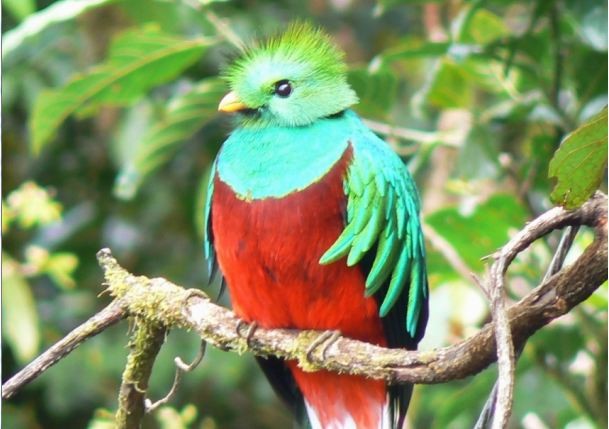Resplendent Quetzal
A species of Typical quetzals Scientific name : Pharomachrus mocinno Genus : Typical quetzals
Resplendent Quetzal, A species of Typical quetzals
Botanical name: Pharomachrus mocinno
Genus: Typical quetzals
Content
Description People often ask General Info
 Photo By Quetzal01.jpg , used under CC-BY-SA-3.0 /Cropped and compressed from original
Photo By Quetzal01.jpg , used under CC-BY-SA-3.0 /Cropped and compressed from original Description
This species is 36 to 40 cm (14–16 in) long, plus up to 65 cm (26 in) of tail streamer for the male, and weighs about 210 g (7.4 oz). It is the largest representative of the trogon order. The subspecies costaricensis is slightly smaller than the nominate race, with tail plumes that are both shorter and narrower. Resplendent quetzals have a green body (showing iridescence from green-gold to blue-violet) and red breast. Depending on the light, quetzal feathers can shine in a variant of colors: green, cobalt, lime, yellow, to ultramarine. Their green upper tail coverts hide their tails and in breeding males are particularly splendid, being longer than the rest of the body. Though quetzal plumages appear green, they are actually brown due to the melanin pigment. The primary wing coverts are also unusually long and give a fringed appearance. The male has a helmet-like crest. The bill, which is partly covered by green filamentous feathers, is yellow in mature males and black in females. Their iridescent feathers, which causes them to appear shiny and green like the canopy leaves, are a camouflage adaptation to hide within the canopy during rainy weather. The skin of the quetzal is very thin and easily torn, so it has evolved thick plumage to protect its skin. Like other members of the trogon family, it has large eyes that adapt easily to the dim light of its forest home. The "song" is a treble syllable described as kyow or like "a whimpering pup", often in pairs, which may be repeated monotonously. Resplendent quetzals have other unmusical calls as well. 
Size
40 cm
Colors
Black
Green
Red
Gray
White
Cyan
Life Expectancy
3-10 years
Nest Placement
Tree
Feeding Habits
Resplendent Quetzal are primarily frugivores, favoring wild avocados and laurel fruits, which they disperse. Insects, frogs, and lizards supplement their diet. Midday foraging involves 'hovering' and 'stalling' to select fruits at branch tips. Adults consume more fruits, while chicks eat more insects.
Habitat
Resplendent Quetzal thrives in montane cloud forests, regions known for dense evergreen vegetation and persistent misty conditions. These birds are suited to elevations where mature, fruit-bearing trees of the laurel family, crucial for their diet, are abundant. Although resplendent Quetzal may forage in clearings, they avoid areas stripped of heavy woodland, reflecting their dependence on a forested environment. They typically occupy canopy or subcanopy layers, and are unique among trogons for their preference for higher altitudes and more mature forests.
Dite type
Frugivorous
People often ask
General Info
Feeding Habits
Bird food type

Fruit
Behavior
Resplendent quetzals are weak fliers. Their known predators include the ornate hawk-eagle, golden eagle, and other hawks and owls as adults, emerald toucanets, brown jays, long-tailed weasels, squirrels, and the kinkajou as nestlings or eggs. 
Distribution Area
Their habitat is montane cloud forest from Southern Mexico to western Panama. 
Species Status
The resplendent quetzal is classified as near threatened on the IUCN Red List due to habitat loss. However, it does occur in several protected areas throughout its range and is a sought-after species for birdwatchers and ecotourists. 
Scientific Classification
Phylum
Chordates Class
Birds Order
Trogons Family
Trogons and quetzals Genus
Typical quetzals Species
Resplendent Quetzal